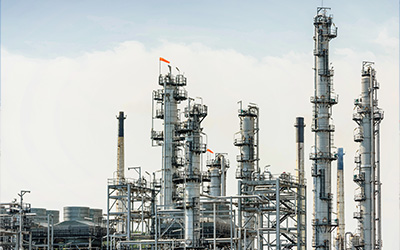Refinery
Isomerization Plant Degassing
Isomerization is a process through which the conversion of n-paraffins to isoparaffins using a platinum catalyst occurs. In other words, a catalyst causes atoms to rearrange and transform the molecules.
For example, A-B-C becomes C-A-B, and though this process is generally clear of fouling from heavy deposits the vessels do contain LEL vapors and light oils. As a result, isomerization plant degassing is required.

Chemical Utilized
Isomerization Plant Process
Refineries may, or may not, have C4 or C5/C6 isomer plants as part of their process. If the plant has a hydrocracker, then there is already enough iso-butane available. Alternately, if a hydrocracker does not exist, a C4 isomer unit produces iso-butane for gasoline blending. If the refinery has a lot of straight-run gasoline but has problems meeting octane numbers, a C5/C6 isomer plant may be in use to convert pentane to iso-pentane and hexane to iso-hexane.
The feed entering the isomer plant consists of n-butane or a mix of butanes. However, the feed cannot contain any olefins as they damage the catalyst.
1
Once the feed enters isomerization the first process is the fractionator. This is where the separation of iso-C4 and n-C4 occurs.
2
Next, hydrogen is added to the mix and charged to the reactor. If the plant is a C5/C6 isomer plant, an additional fractionator splits the C5 from the C6.
3
Then the reactor product goes to a flash tank to remove the hydrogen. The product at the bottom of the flash tank goes to another fractionator to separate C3 and lighter molecules.
4
At the same time, butanes are sent to the fuel blending.
What Problems do the Isomerization Plant Cause?
Like catalytic reformers, isomerization is a clean process. Isomerization plant degassing to remove vapor fouling is important. Contamination of the isomer plants appears in the form of light oils and dangerous LEL vapors.

Our Chemical Cleaning Solution
Isomerization plant degassing is required before personnel can enter the unit safely.
1
Degas the Plant
FQE® LEL-Vapor removes the harmful LEL vapors. These are apparent in the fractionator towers as well as the flash tank. It is recommended that the decontamination of liquids and vapors uses vapor phase cleaning.
2
Degreasing the Plant
FQE LEL-Vapor chemistry is also effective at degreasing any light oils that may be present in the isomerization plant.



